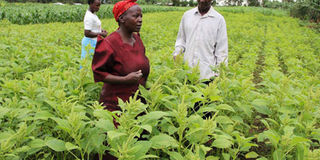Agricultural diversity the key to food security

Sophia Nekesa and her family members, Johnston Imbwatsa and Sarah Amakobe at their farm where they grow amaranth in Lugari, Kakamega in this past photo. Amaranth flour is nutritious and can be made from the crop. Such crops can go a great way in alleviating food insecurity if adopted. FILE PHOTO | NATION MEDIA GROUP
What you need to know:
- Already, one in three people in the world suffers from micronutrient deficiencies, meaning that they lack the requisite vitamins and minerals for proper growth and development.
- To deal with this, scientists are preaching agricultural biodiversity, which means embracing all crops including their wild relatives, trees, livestock and landscapes as a source of nutritious foods.
- Agricultural biodiversity is also a source of essential traits for breeding stress-tolerant, nutritious crops and animal breeds and is often adapted to indigenous and low-input agricultural techniques.
With a rapidly changing climate starring extreme weather, the possibility of food insecurity and prevalent dietary deficiencies have never loomed larger.
Scientists say that going back to our roots and to the forgotten foods from our past could help turn the tide.
Already, one in three people in the world suffers from micronutrient deficiencies, meaning that they lack the requisite vitamins and minerals for proper growth and development.
Forecasts by the Intergovernmental Panel on Climate Change show that climate change could lessen agricultural production to two per cent, while demand for agricultural produce increases by approximately 14 per cent every decade.
To deal with this, scientists are preaching agricultural biodiversity, which means embracing all crops including their wild relatives, trees, livestock and landscapes as a source of nutritious foods.
“Agrobiodiversity, which makes up the edible plant and animal species that feeds us as humans, holds the key to our future food security. But we are failing to protect and tap into its potential to transform our food systems for the better,” says Ann Tutwiler, the director general of Bioversity International.
This calls for restructuring food systems by drawing attention to edible plants and organisms from the past that were pushed to the back burner by modernisation, and getting them back on dinner plates nourishing people with high-quality diets sustainably, while protecting the environment and farming systems.
STILL UNEXPLORED
“Grain amaranth, jute leaves, bambara groundnuts, edible spider plant, fruits like guavas, bitter melon and plantain red banana (gonja) and sweet bananas, traditional vegetables such as amaranth, African nightshade, products from native trees such as baobab and varied ant and insect species among other neglected yet healthy foods can be made cool again and consumed,” says Céline Termote, an associate scientist at the Consultative Group for International Agricultural Research’s (CGIAR) Bioversity International.
From 391,000 documented plant species, only about a quarter have been counted as suitable for human consumption, and only a handful provide more than 50 per cent of the world’s plant-derived calories, despite there being more, still unexplored yet edible varieties, which are often shunned.
Banking so heavily on such a narrow food and nutrition resource base is a risky strategy for the general public, individual livelihoods and nutritious diet provision, according to a report titled Mainstreaming Agrobiodiversity in Sustainable Food Systems, by a team of researchers who include Termote.
Agricultural biodiversity is also a source of essential traits for breeding stress-tolerant, nutritious crops and animal breeds and is often adapted to indigenous and low-input agricultural techniques.
While it is by no means the only component needed in a sustainable nutritious food system, a sustainable food system hardly ever exists without agricultural biodiversity, says Termote.





